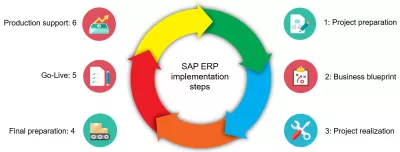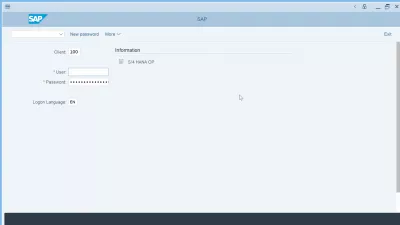SAP implementation steps
SAP ERP implementation methodology
There are 6 steps to a successful SAP project implementation:
– project preparation, in which the whole project is planned,
– business blueprint, in which workshops are organized and requirements are detailed,
– realization, in which the business process requirements are implemented,
– final preparation, in which testing, training, and cutover activities takes place,
– go-live, during which the transition to the new system is effective,
– support, during which a specific attention is placed until the business is back to normal.
ASAP Methodology: SAP Implementation Phases
5 steps of sap implementation

Step 1: project preparation
During the first step of a SAP project, the early preparation activities are taking place.
In that phase, it is important to perform the following tasks:
– specify the needs and boundaries. What is included in the project, which workstreams will be migrated, which processes will be moved, and which will not,
– identify the actors. Who will effectively perform project tasks, at which part, how to manage their project involvement, and ensure business continuity while they are focused on the project,
– draft the project plan. How many phases of the project, which countries or plants will go live during which phase, what is the timeline, how the quality gates will be measured.

Step 2: business blueprint
Before being able to start effectively to implement the program, it is important to identify in detail what has to be done.
A series of workshops have to be organized, with everybody involved in the project.
To ensure a good project implication from everybody, it is usually good to start with a big project meeting, inviting physically everybody involved in the project to tell them what is expected from them, what is at stake, how it will be organized.
Then, workshops can be organized by workstreams. What is the goal reach, go process by process, and see how it can be done in SAP.
During the workshops, the gaps and satellites are identified in details, along with the organizational structure that will be necessary.
The business process gaps is the list of differences between the current organization, and the future process. Each gap will have to be solved before go live and properly tested, and any of them could prevent project from happening if not solved.
The satellites are the list of programs that will not be taken in SAP, but that will be used in parallel even after go-live.
The organization structure is the list of basic information that must be customized in the SAP system to allow any process to happen, such as the company offices locations, the tax applied in the countries, and many more.
paper, document, plan, pencil, business, construction, office, project, design, blueprint

Step 3: realization
Once the analyze has been done, it is time for the project central team to start implementing the project.
The organizational information is entered in SAP, the gaps processes solutions are being worked on, the data is prepared to be migrated in the new system, and the project phases are ongoing.
At defined points in time, a test system of SAP with current project advancement is setup, and tested. First step could be one system only with customization, next step with 50% of functionalities implemented, next step a month before go-live with a full simulation.
technology, laptop computer, desk, computer keyboard, office, hand, work

Step 4: final preparation
The final preparation is not only system-wise, but also people wise.
Everybody has to be trained on the new processes with production like data, and the full set of processes has to be tested and validated in an SAP system.
All processes must be fully defined, and no more gaps should exist, they must all have been solved by this project preparation phase.
Unless the system is not 100% ready for transition, the next step, go-live, should be postponed.
Checklist Man People Box Hand Goals Pen Notebook

Step 5: Go-live
The Go-Live is one of the most critical part of the project, in which everybody involved puts his maximum attention, and any issue could have maximum impact.
The Go-Live includes the following phases:
– former system stop, as it won’t be used anymore, the financial periods must be closed, and no further business can happen in the old system,
– final data migration, in which the data is taken from previous system after closure, and moved to the new SAP ERP,
– cutover transition continues with the start of the new SAP system, with some quick tests to validate that all went well.
Once this has been done, a business ramp up is usually planned. For a few days, maximum attention is put to a minimum of business, and it is quickly ramped up to previous volumes within a few weeks, while the potential issues are being solved by the full project team that is still present.

Step 6: production support
Once the new system is used, the next step is to support its use, with potential usage of a ghost version of the previous system.
In that phase, the project members are still reachable, but the team has been seriously reduced, either back at their real jobs, having moved on to new roles, or working on the next project phases.
A dedicated team is however there to help with any issue that might arise, and potential gaps that haven’t been found earlier are taken in consideration carefully.
The Infusion rollercoaster’s structural support, at Blackpool Pleasure Beach

SAP ERP implementation phases
The SAP ERP implementation steps must be followed to ensure a successful project implementation, and the switch from another ERP system to the SAP ERP.
Regardless of the version of SAP used, these are the steps to followed, and it is important that they are understood by the whole actors, and properly implemented to ensure a successful project.

Read more
- ASAP Methodology: SAP Implementation Phases
- 5 steps of sap implementation
- Step 1: project preparation
- paper, document, plan, pencil, business, construction, office, project, design, blueprint
- technology, laptop computer, desk, computer keyboard, office, hand, work
- Checklist Man People Box Hand Goals Pen Notebook
- An exhaust plume surrounds the mobile launcher platform on Launch Pad 39A as space shuttle Atlantis lifts off on the STS-132 mission. Image credit: NASA/Tony Gray and Tom Farrar
- The Infusion rollercoaster’s structural support, at Blackpool Pleasure Beach

